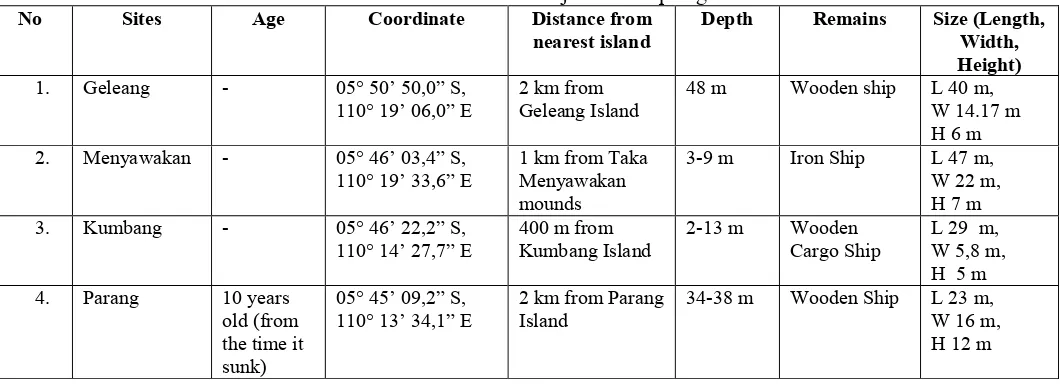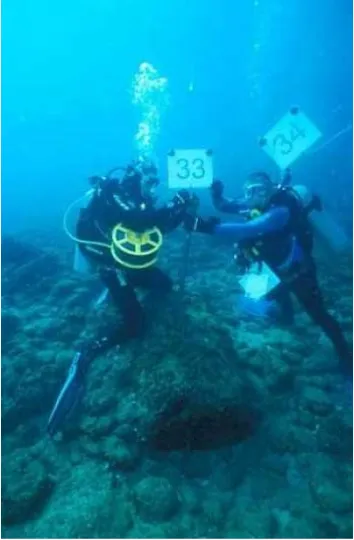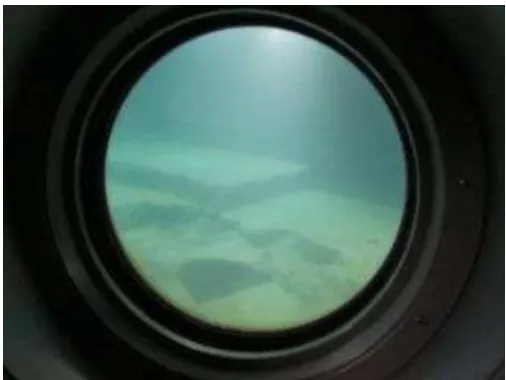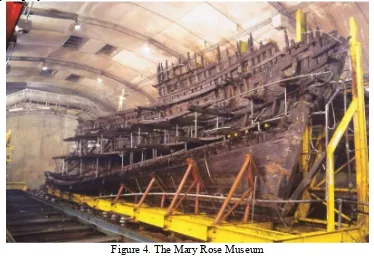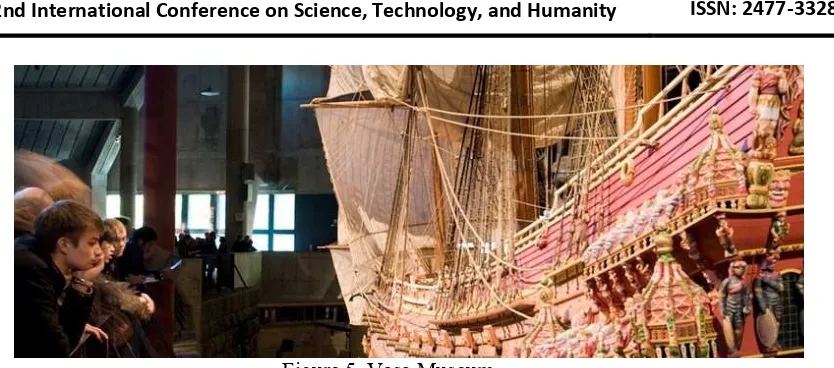The 2nd International Conference on Science, Technology, and Humanity ISSN: 2477-3328
Underwater Archaeological Museum:
Utilization of Karimunjawa Sites
St. Prabawa Dwi Putranto*, Prof Agus Aris Munandar University of Indonesia, Faculty of Humanities,
Depok, West Java, Indonesia
*
Corresponding Email: stprabawa@yahoo.co.id
Abstract
Indonesia is located in a strategic location between Indian and Pacific Ocean. Indonesia has water territory more than land territory with approximately 3:2 in ratio. In that vast area, there are many cultural heritages from old history, both in land and underwater. Cultural heritages found in both locations have a connection.
Until recently, the government has attempted to reveal the past from underwater cultural heritage through survey and exploration. Many invaluable cargoes were salvaged from the underwater wreckages. Exploration and salvage are done by private company with the permit from the National Committee for Salvage and Utilization of the Valuable Object of the Sunken Ship (PANNAS BMKT). However, illegal exploration and salvage persists in the practice. Conservation efforts that include protection, development and utilization to the underwater cultural heritage had not been maximal; therefore, salvage, pilferage, and vandalism still occur.
This paper would try to give an alternative for the utilization of underwater cultural heritage through a maritime museum in its natural state (in-site conservation). Museum is one institution that protects, develops and utilizes cultural heritages, and communicates them to the visitor.
Keywords: museum, cultural heritage, underwater archaeology, cultural property
1.
Introduction
Indonesia is located in a strategic location of trade route, between the Asian and Australian Continent, also Indian and Pacific Ocean. Indonesian water contains many underwater cultural heritages that served major roles in shaping the Indonesian culture. These cultural heritages contain information connected to the history and the culture of Indonesian people.
Underwater archaeology is one of archaeology study that focuses on material culture in water. The UNESCO Convention on the Protection of the Underwater Cultural Heritage Article 1 defined underwater heritage asμ
“nderwater archaeology is one of archaeology study that focuses on material culture in water. The UNESCO Convention on the Protection of the Underwater Cultural Heritage Article 1 defined underwater herita
The 2nd International Conference on Science, Technology, and Humanity ISSN: 2477-3328
un-renewable, fragile, irreversible, and unique (Green & Moore, 2010, p. 108). Therefore, it needs proper management to preserve it, especially for underwater cultural heritage1 (UCH).
The preservation of UCH is mostly done by the government. Until recently, the government has attempted to reveal the past from underwater cultural heritage through survey and exploration. Many invaluable cargoes were salvaged from the underwater wreckage. Exploration and salvage are done by private company with the permit from the National Committee for Salvage and Utilization of the ↑aluable Object of the Sunken Ship (PANNAS BMKT). However, illegal exploration and salvage persists in the practice.
The salvage done was focused on the ship’s cargo; the ship itself is cast aside. The information about the ship serves only as a complement for the explanation of the cargo. Often, in the attempt to get the cargo, ship hull must be damaged and therefore loses its archaeological value. Meanwhile shipwreck and its cargo are valuable resources to the preservation of UCH.
In the UNESCO Convention on the Protection of the Underwater Cultural Heritage, the in situ preservation of underwater cultural heritage shall be considered as the first and preferred option before allowing or engaging in any activities directed at this heritage. The recovery of objects may however be authorized for the purpose of making a significant contribution to the protection of knowledge on the underwater cultural heritage. In certain case, if a shipwreck or an underwater site is in peril, the removal and raise process are done in a documentation procedure according to the archaeological principles.
→ith many UCH types contained in Indonesia, types of preservations that are appropriate for the site and environmental condition need to be formulated. In order to increase people’s awareness about the importance of UCH preservation, the most important thing to do is to provide information about UCH and its efforts to preserve it. This paper would discuss one alternative of UCH preservation, which was through an underwater museum, and the research was conducted in Karimunjawa, Central Java as its case study.
2.
Underwater Cultural Heritage in Karimunjawa
The 2nd International Conference on Science, Technology, and Humanity ISSN: 2477-3328
Karimunjawa Archipelago is located northeast of Semarang precisely in 5°40΄γλ” - 5°55’00” S dan 110°05΄57” - 110°γ1΄15” E. It is located in the administrative region of District Jepara, consisting of three village, Karimunjawa, Kemujan, and Parang. Its land and water area covers 117.237 Ha, consisting of 27 islands. There are only four inhabited islands, which are Karimunjawa, Kemujan, Parang, and Nyamuk Island.
Karimunjawa Archipelago location is very strategic to the shipping line and trade route of Java Sea. According to the Chinese chronicles, in 1292 A.D, 20000 fleets envoy of Kubilai Khan led by Shih Pi, Kau Sing and Ike Mese sailed to Java to punish King Krtanegara (Singasari Kingdom). These fleets stopped at Biliton (Belitung), and then anchored in Karimon (Karimunjawa), waiting for the opportunity to enter Du-bing-zu (Tuban) (Groeneveldt, 2009: 32). In other Chinese Chronicles, Shun Feng Hsiang Sung who made the shipping route between China and Indonesian Archipelago, Chi Li Wen or Karimunjawa was depicted as an important place to the shipping between Wu Yu near Amoy (China) and Tu Ping Shu (Tuban) (Noerwidi, 2008, p. 5).
In the times of Demak Sultanate, when the main harbor shifted from Tuban to Jepara, Karimunjawa was still considered as a strategic location for transit in the Java Sea. The political control of Karimunjawa was managed by the Islamic Sultanate by sending mubaliq to convert the island residents to Islam. Among these notable figures who came to the island, one of them was Sunan Nyamplung or Mbah Amir Khasan (Koestoro, 1997, p. 41-43).
In the 17th century, Jepara’s role as the main harbor was replaced by Semarang. Even though the main harbor changed again, Karimunjawa was still considered as an important transit harbor. According to the Dutch record, in 18th and 19th Century, furniture craftsmen in Batavia brought in its sonokeling wood (Indonesian rosewood) from Karimunjawa. In 1815, Carel Rudolph von Michalovski, a Germany officer was appointed as the first posthouder to govern Karimunjawa. At the time of the Dutch Indies, Karimunjawa was administratively under the Resident of Semarang (Anwar, 2004, p. 188-189).
In Karimunjawa Archipelago, there are various UCH sites scattered all over the region.2 These sites are mainly shipwreck, but there are sites that contain fragment of ceramic. Its depth varied from 10 to 50 m deep.
Table 1. UCH in Karimunjawa Archipelago
No Sites Age Coordinate Distance from
nearest island
Depth Remains Size (Length, Width,
2Data about the coordinate and description of UCH were acquired from Data Collection Indonesian Underwater
The 2nd International Conference on Science, Technology, and Humanity ISSN: 2477-3328
Museum is a place that contains information about human culture to be presented to the society as a source of knowledge. In general, museum is a building that presents collection and information related to certain theme and contains certain messages. In Indonesia, underwater museum is novel, even though there are many UCH in Indonesia.
In general, underwater museum can be interpreted as a museum that displays collection and information about underwater cultural heritage such as shipwrecks, sunken plane, as well as underwater sites. Many of those heritages are still in their original location which is in-situ, as well as heritage that has been raised from its site or commonly called as ex-situ. According to its collection location, underwater museum can be distinguished into two typesμ in-situ and ex-situ.
1.1. In-Situ Underwater Archaeological Museum
This kind of museum displays UCH in its original context. As the conservation effort is done in-situ, the heritages that are being displayed are in its original site. The main principles of an in-situ presentation among others areμ
Stresses the importance of and respect for the historical context of the cultural objects and its scientific significance;
Recognizes that, under normal circumstances, heritage is well preserved under water owing to the low deterioration rate and lack of oxygen; and that it is, therefore, not per se in danger.
In-situ underwater museum can be divided in to two based on its way of visit, that is with diving or without diving. Underwater museum with diving requires its visitor to dive in order to see its collections. These museums provide guidance to the visitor in the form of maps and trail information to see the collections, which are usually contained in several locations. Signposts are placed to guide the visiting divers. These types of museum are very supportive of preserving the cultural objects, but the visitor is limited with its ability to dive. Therefore, the effort to socialize UCH becomes limited.
The 2nd International Conference on Science, Technology, and Humanity ISSN: 2477-3328
coast of Israel. This museum was inaugurated in 2006. Besides visiting an old harbor, the visitors can also see roman shipwreck, remnants of a lighthouse, an old wave breaker, the early foundation of the harbor, and an old anchor. The technology used in making the harbor is quite unique because it uses Roman technology in the form of hydraulic concrete known as pozzolana. These hydraulic concretes consist of volcanic ashes, lime, and sand which harden in the sea. In visiting this museum, the visitors are given a waterproof map in details describing 36 UCHs. There are four trails for the visitors. One of that trails can only be accessed by using snorkeling equipment.
Figure 1. Caesarea Underwater Museum
The 2nd International Conference on Science, Technology, and Humanity ISSN: 2477-3328
Figure 2. The Florida Keys National Marine Sanctuary
There is also an in-situ underwater museum, in which the visitors do not need to dive to see the collections. This museum is designed in such a way so that the visitors can see the UCH without diving underwater. This is much easier for the visitors with limited and no diving skill. Within certain depth, the management constructed an aisle or underwater lane or underwater flooring if the site is in shallow-depth water. One example is the Museum Baiheliang, China. Baiheliang is an archaeological site in Fuling, China. This site is underwater in the Three Gorges reservoir. It displayed one of the oldest hydrological inscriptions, which record a 1200 year of changes in water level of the Yangtza River in the northern part of Fuling District, in the town of Chongqing. The underwater site is in a 43 m depth. In this museum, the visitors can see the inscription without diving, by means of entering an underground tunnel and see the inscription through a looking glass.
The 2nd International Conference on Science, Technology, and Humanity ISSN: 2477-3328
1.2. Ex-Situ Underwater Archaeological Museum
Ex-situ underwater archaeological museum displays UCH which are not in its original contexts and sites. The UCH have gone through a raising process from underwater. The display and conservation of this UCH are done on land.
One of ex-situ underwater museums is Mary Rose Museum in the United Kingdom. It is located in Portsmouth, displaying a Tudor Warship from the 16th century. Mary Rose is one of the main ships in the fleet of King Henry VIII. It was built in 1509-1510, and sunk in 1545 when leading the battle against France. Later, it was discovered in 1971, raised in 1982, and promptly displayed in a museum.
Figure 4. The Mary Rose Museum
The 2nd International Conference on Science, Technology, and Humanity ISSN: 2477-3328
Figure 5. Vasa Museum
2.
Underwater Archaeological Museum in Karimunjawa Sites
Indonesia has already have a museum that displayed the maritime history of Indonesia which is Maritime Museum in Jakarta and Bintan, while the Maritime Museum in Belitung is still under construction. In these museums, we can see many naval collections such as, boats, ceramics, navigation tools, and weapons, which displayed the maritime history of Nusantara or Indonesian Archipelago. The collections from underwater found in these museums are merely the ceramic collections from the salvage conducted by the PANNAS BMKT.
In Indonesia, there are still many UCHs in the form shipwrecks that have become the location of wreck dive in national and international scope, as in Karimunjawa Archipelago. According to its remains, this location is suitable to become an in-situ underwater museum. However, it needs proper management which should structured by a reliable institution or a legal body, which will organize the information as well. Of course there are many things that need to be prepared such as funding, organization, human resources, and information.
There are many ways to preserve the underwater cultural heritage, but the most important aspect is the main principles of preservation, which are non-destructive effort and maintaining the sustainability for future generation, and be beneficial for the public. Therefore, this type of underwater museum can be one of the options for the preservation of underwater cultural heritage.
UCH management by utilizing the model of underwater museum would have some advantages, as well as some challenges. The utilization of underwater museum for archaeological underwater sites in Karimunjawa would be very potential in some areas. Those potentials areμ
1. UCH Preservation
With its strategic location, Karimunjawa was used as a transit harbor in Java Sea. It was a busy harbor visited by many foreign and local ships. A considerable numbers of UCH in Karimunjawa describe Indonesia as a maritime nation that is capable of roaming the sea and had relation with many foreign nations in the past. By utilizing the sites as museums, we could maintain the preservation of the wreck sites and its environment to last for the future generation to learn.
2. Education and science
The 2nd International Conference on Science, Technology, and Humanity ISSN: 2477-3328
3. Political
The preservation of UCH can support the Government’s program to make Indonesia as a maritime axis with the concept of Nawa Cita from the President of Indonesia, Joko Widodo.
4. Economy
Economically, tourism in Karimunjawa is very high. Wreck diving could be the main attraction for visiting tourists. Other than that, indirect economical benefit from tourists can lift the standard of living of the Karimunjawa people.
5. Information Dissemination
Information about the importance of Karimunjawa sites and its history needs to be developed and packed to be publicized for public consumption. Therefore, it can increase people’s awareness to protect and preserve UCH in Karimunjawa and, furthermore, in other regions in Indonesia.
On the other hand, the potential of utilizing UCH as a museum in Karimunjawa would face some challenges since it is a new concept in Indonesia and has not been implemented in any other sites in Indonesia. Those challenges include:
1. Lack of information about UCH sites in Karimunjawa; therefore, it needs more research to discover the data and information behind the sites
2. Lack of knowledge about UCH management among the local government, because UCH management in local area is the responsibility of the local government
3. Vandalism through human activity and natural process would cause some changes or degradation of the UCH sites
4. Lack of access to Karimunjawa; since the transportation from Java (Jepara and Semarang) is very limited, it would cause some difficulties for tourists to visit Karimunjawa
5. Need a big amount of funding and special skills of human resources to manage UCH sites as a museum because it is a very special major.
The degradation of UCH sites in Karimunjawa would continue to increase as time goes. It needs our awareness to protect the sites. The concept of utilizing UCH sites as an underwater museum could considered as one method of preserving sites. Therefore, archaeological sites preservation through museum is very important to be conducted as an identity of Indonesian people and its existence is necessary to be maintained for the education of the next generation.
References
Anwar, Rosihan (2004). Sejarah Kecil “Petit Histoire” Indonesia. Jakarta: Kompas.
Directorate of the Underwater Heritage (2011). Himpunan Data Cagar Budaya Bawah Air Indonesia. Jakarta: Ministry of Education and Culture.
Green, K, & Moore, T (2010). Archaeology: An Introduction. New York: Routledge.
The 2nd International Conference on Science, Technology, and Humanity ISSN: 2477-3328
Internet
Frucht, LeoraEren “Israel launches world's first underwater museum”
in httpμ//israelβ1c.org/culture/israel-launches-worlds-first-underwater-museum/
Hayes, Holly, “Underwater Museum Casarea”, in httpμ//www.sacreddestinations.com/ israel/caesarea-underwater-museum.
Noerwidi, Sofwan (2008).Jejak Kejayaan Bahari Karimunjawa in http://arkeologika.files.wordpress.com/2008/01/sofwan_bahari.pdf, 2008.
“The Baiheliang Underwater Museum, Fuling, Chongqing Municipality, China” in http://www.unesco.org/new/en/culture/themes/underwater-cultural-heritage
“Shipwreck Trail”, in httpμ//floridakeys.noaa.gov/shipwrecktrail/welcome.html httpμ//www.maryrose.org/
